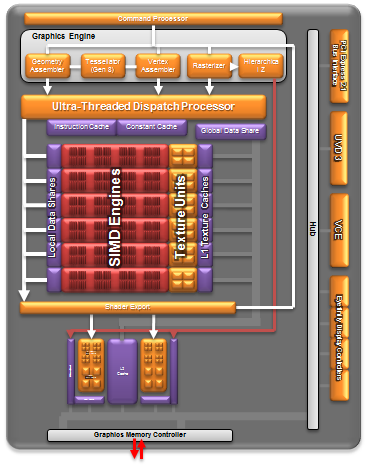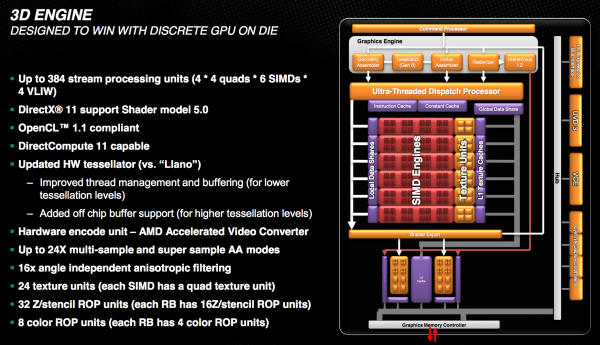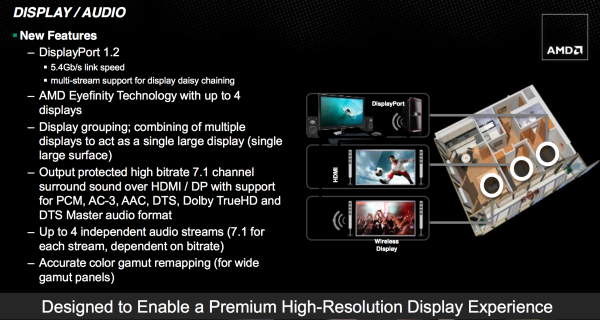The AMD Trinity Review (A10-4600M): A New Hope
by Jarred Walton on May 15, 2012 12:00 AM ESTImproved Turbo
Trinity features a much improved version of AMD's Turbo Core technology compared to Llano. First and foremost, both CPU and GPU turbo are now supported. In Llano only the CPU cores could turbo up if there was additional TDP headroom available, while the GPU cores ran no higher than their max specified frequency. In Trinity, if the CPU cores aren't using all of their allocated TDP but the GPU is under heavy load, it can exceed its typical max frequency to capitalize on the available TDP. The same obviously works in reverse.
Under the hood, the microcontroller that monitors all power consumption within the APU is much more capable. In Llano, the Turbo Core microcontroller looked at activity on the CPU/GPU and performed a static allocation of power based on this data. In Trinity, AMD implemented a physics based thermal calculation model using fast transforms. The model takes power and translates it into a dynamic temperature calculation. Power is still estimated based on workload, which AMD claims has less than a 1% error rate, but the new model gets accurate temperatures from those estimations. The thermal model delivers accuracy at or below 2C, in real time. Having more accurate thermal data allows the turbo microcontroller to respond quicker, which should allow for frequencies to scale up and down more effectively.
At the end of the day this should improve performance, although it's difficult to compare directly to Llano since so much has changed between the two APUs. Just as with Llano, AMD specifies nominal and max turbo frequencies for the Trinity CPU/GPU.
A Beefy Set of Interconnects
The holy grail for AMD (and Intel for that matter) is a single piece of silicon with CPU and GPU style cores that coexist harmoniously, each doing what they do best. We're not quite there yet, but in pursuit of that goal it's important to have tons of bandwidth available on chip.
Trinity still features two 64-bit DDR3 memory controllers with support for up to DDR3-1866 speeds. The controllers add support for 1.25V memory. Notebook bound Trinities (Socket FS1r2 and Socket FP2) support up to 32GB of memory, while the desktop variants (Socket FM2) can handle up to 64GB.
Hyper Transport is gone as an external interconnect, leaving only PCIe for off-chip IO. The Fusion Control Link is a 128-bit (each direction) interface giving off-chip IO devices access to system memory. Trinity also features a 256-bit (in each direction, per memory channel) Radeon Memory Bus (RMB) direct access to the DRAM controllers. The excessive width of this bus likely implies that it's also used for CPU/GPU communication as well.
IOMMU v2 is also supported by Trinity, giving supported discrete GPUs (e.g. Tahiti) access to the CPU's virtual memory. In Llano, you used to take data from disk, copy it to memory, then copy it from the CPU's address space to pinned memory that's accessible by the GPU, then the GPU gets it and brings it into its frame buffer. By having access to the CPU's virtual address space now the data goes from disk, to memory, then directly to the GPU's memory—you skip that intermediate mem to mem copy. Eventually we'll get to the point where there's truly one unified address space, but steps like these are what will get us there.
The Trinity GPU
Trinity's GPU is probably the most well understood part of the chip, seeing as how its basically a cut down Cayman from AMD's Northern Islands family. The VLIW4 design features 6 SIMD engines, each with 16 VLIW4 arrays, for a total of up to 384 cores. The A10 SKUs get 384 cores while the lower end A8 and A6 parts get 256 and 192, respectively. FP64 is supported but at 1/16 the FP32 rate.

As AMD never released any low-end Northern Islands VLIW4 parts, Trinity's GPU is a bit unique. It technically has fewer cores than Llano's GPU, but as we saw with AMD's transition from VLIW5 to VLIW4, the loss didn't really impact performance but rather drove up efficiency. Remember that most of the time that 5th unit in AMD's VLIW5 architectures went unused.
The design features 24 texture units and 8 ROPs, in line with what you'd expect from what's effectively 1/4 of a Cayman/Radeon HD 6970. Clock speeds are obviously lower than a full blown Cayman, but not by a ton. Trinity's GPU runs at a normal maximum of 497MHz and can turbo up as high as 686MHz.
Trinity includes AMD's HD Media Accelerator, which includes accelerated video decode (UVD3) and encode components (VCE). Trinity borrows Graphics Core Next's Video Codec Engine (VCE) and is actually functional in the hardware/software we have here today. Don't get too excited though; the VCE enabled software we have today won't take advantage of the identical hardware in discrete GCN GPUs. AMD tells us this is purely a matter of having the resources to prioritize Trinity first, and that discrete GPU VCE support is coming.















271 Comments
View All Comments
Kaggy - Tuesday, May 15, 2012 - link
And at lower power consumption.Pantsu - Tuesday, May 15, 2012 - link
Unfortunately for AMD, the processor is only a small part of the laptop BOM. Even if Trinity is cheaper, the difference in the end product is not that big. Still, the mainstream 15" cheapo laptop is perhaps the last refuge AMD has.Looks like Trinity is still the way to go for low end gaming, but it's disconcerting to see HD4000 actually beat it in few tests. AMD really needs to get a better CPU architecture going.
HSA is still long ways to go too, and I just don't see AMD pulling off the necessary developer support for it to really work, unless Intel goes along the same lines, in which case they might as well just give up.
iwod - Tuesday, May 15, 2012 - link
I am guessing Haswell will have some CPU improvement with FMA, New AVX, etc... and 3 times faster Graphics..... I dont see Trinity or what ever behind it having too much hope.I am also wondering if Intel could further improve those games performance with better drivers. Again Intel may have caught up with the hardware department ( The easier part ), their drivers are still lacking behind.
Spunjji - Tuesday, May 15, 2012 - link
I'd like to think that an AMD CPU with their current GCN graphics on a 28nm-or-smaller process would at least be GPU competitive with Intel. We live in interesting, times, though.duploxxx - Tuesday, May 15, 2012 - link
you can always believe marketing that they will be able to perform that kind of GPU leap while in the past they have always struggled to enhance. Sure the 4000 is already getting better (near Liano perf) it only shines in the few synthetical benchmarks and where the AMD is limited to CPU performance.perhaps try a few higher res games and see how much is left from the Intel GPU...
AMD is limited to memory bandwidth, Intel will suffer from the same.
cyrusfox - Tuesday, May 15, 2012 - link
So when will I be able to find a good trinity laptop with backlit keyboard in a small 13" form factor or preferably smaller. I would like to upgrade from brazos, and brazos 2.0 isn't going to hack it.JarredWalton - Tuesday, May 15, 2012 - link
This is the hard part: just about every OEM that makes an AMD laptop ends up targeting the budget market, and in that market they cut every corner possible. Forget quality LCDs (which would add around $10 to the BoM for most laptops), forget better build materials, and forget amenities like backlit keyboards. Oh, I'm sure someone will make a Trinity laptop with a backlit keyboard, but then they'll probably ask $800 for it. HP has their Envy 14 coming in "Sleekbook" trim that might get you a backlit keyboard, though--and it's price starts at $700.FrontBoard - Tuesday, May 15, 2012 - link
Trinity is the name of a river in Texas, just as Comal and Brazos are. That is likely where the codenames come from.kevith - Tuesday, May 15, 2012 - link
Thanks!JarredWalton - Tuesday, May 15, 2012 - link
For the record, I *did* know that AMD is grabbing names of rivers. I guess it could be better stated: "I wonder if AMD was trying to have a secondary meaning with their codename." And it was a nice hook for the conclusion. :-)